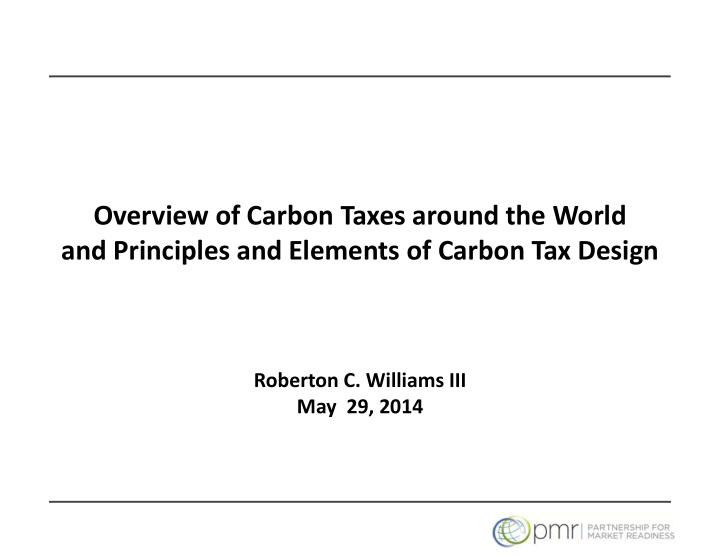



Overview of Carbon Taxes around the World and Principles and Elements of Carbon Tax Design Roberton C. Williams III May 29, 2014
Outline What is a carbon tax? 1. Brief overview of carbon taxes around the world 2. Key issues in carbon tax design 3. Brief comments on choosing among carbon pricing 4. instruments (tax vs. ETS) 2
What is a carbon tax? Carbon tax: tax on CO 2 emissions 3
What is a carbon tax? Carbon tax: tax on CO 2 emissions Can be implemented “upstream” (on carbon content of fuels), “downstream” (on emitters), or some combination (upstream tax on fuels, downstream tax on process emissions) 4
What is a carbon tax? Carbon tax: tax on CO 2 emissions Can be implemented “upstream” (on carbon content of fuels), “downstream” (on emitters), or some combination (upstream tax on fuels, downstream tax on process emissions) Key characteristics: Broad tax on many (theoretically all) sources of emissions Tax based on emissions, not on value or energy content 5
What is a carbon tax? Carbon tax: tax on CO 2 emissions (and other GHGs?) Can be implemented “upstream” (on carbon content of fuels), “downstream” (on emitters), or some combination (upstream tax on fuels, downstream tax on process emissions) Key characteristics: Broad tax on many (theoretically all) sources of emissions Tax based on emissions, not on value or energy content Other energy taxes can approximate a carbon tax 6
Carbon Taxes around the World Northern European countries in early 1990s (Finland, Netherlands, Norway, Sweden, Denmark) 7
Carbon Taxes around the World Northern European countries in early 1990s (Finland, Netherlands, Norway, Sweden, Denmark) Ireland, UK 8
Carbon Taxes around the World Northern European countries in early 1990s (Finland, Netherlands, Norway, Sweden, Denmark) Ireland, UK British Columbia 9
Carbon Taxes around the World Northern European countries in early 1990s (Finland, Netherlands, Norway, Sweden, Denmark) Ireland, UK British Columbia India (coal only), Mexico, South Africa 10
Carbon Taxes around the World Northern European countries in early 1990s (Finland, Netherlands, Norway, Sweden, Denmark) Ireland, UK British Columbia India (coal only), Mexico, South Africa Under consideration: Brazil, Chile, China, others 11
Design: Tax Base Theoretical tax base: all GHG emissions In practice, this is impossible Advantages of broader coverage More cost-effective emissions reductions: same marginal incentive for reductions across broad range of sources Higher revenue potential Simplicity and fairness Advantages of narrower coverage Easier measurement and enforcement (particularly for downstream tax, which is harder to monitor and enforce) Could exempt vulnerable/politically powerful sectors (but probably better to use tax credits) 12
Design: Tax Rate Theoretical ideal: tax on all GHG emissions worldwide, at rate equal to marginal damage from climate change In practice, many factors to consider Damage: just climate change? Local pollution damage, too? Revenue needs Emissions targets (either emissions levels or intensities) Carbon prices in other countries 13
Design: Tax Rate Changes over Time Tax rate should generally rise over time How fast a rise? And how to decide? Initial phase-in: Most efficient is to implement full rate immediately, but this can cause political & distributional problems Phasing in rate can alleviate these problems, at potentially low efficiency cost After initial phase-in, rate change determined by damages, emissions targets, revenue needs, etc. Adjustment: predictable price path helps with investment decisions, but value to flexibility, too 14
Design: Use of Revenue Carbon tax revenue has many potential uses Investments for the future (education, infrastructure, etc.) Fiscal consolidation/deficit reduction Revenue-neutral tax reform: cut inefficient taxes Compensation to industries or households Other public spending, including environmental programs Factors to consider: Effects on economic growth (short and long run) Value of other public spending Political implications 15
Design: Compensating industry/households Need to limit burden on industries and households that are vulnerable (or politically powerful) Tax credits Key is credit based on historical emissions (like grandfathering) or output (like benchmarking), rather than based on emissions Tax exemptions May seem simpler, but hurt cost-effectiveness (eliminate price signal for exempted industries) Need for careful analysis: overcompensation is costly Either system needs to address effect on vulnerable households (use of revenue can help here) 16
Design: Integration with other policies Offsets: encourage reductions in non-covered sectors Can have tax on emissions minus offsets Can offer tax credit for offsets Can have government use some revenue to buy offsets Integration with trading Tax can act as floor price with trading Tax can collect some revenue within trading system Integration with other programs Other policies can encourage new technology, tax encourages emissions reductions Need to be careful about complexity and redundancy 17
Choosing among Carbon Pricing Instruments ETS and tax are more similar than they are different Both price carbon, providing incentive for cost-effective emissions reductions and flexibility in how to achieve those reductions Both can provide predictable price path, compensate affected industries and households, etc. Design of ETS or tax may be more important than choice between ETS and tax Legal and institutional factors may be important Existing fuel taxes can be adapted into a carbon tax Existing institutional capacity of enforcing agency 18
Thank you for your attention 19
Recommend
More recommend